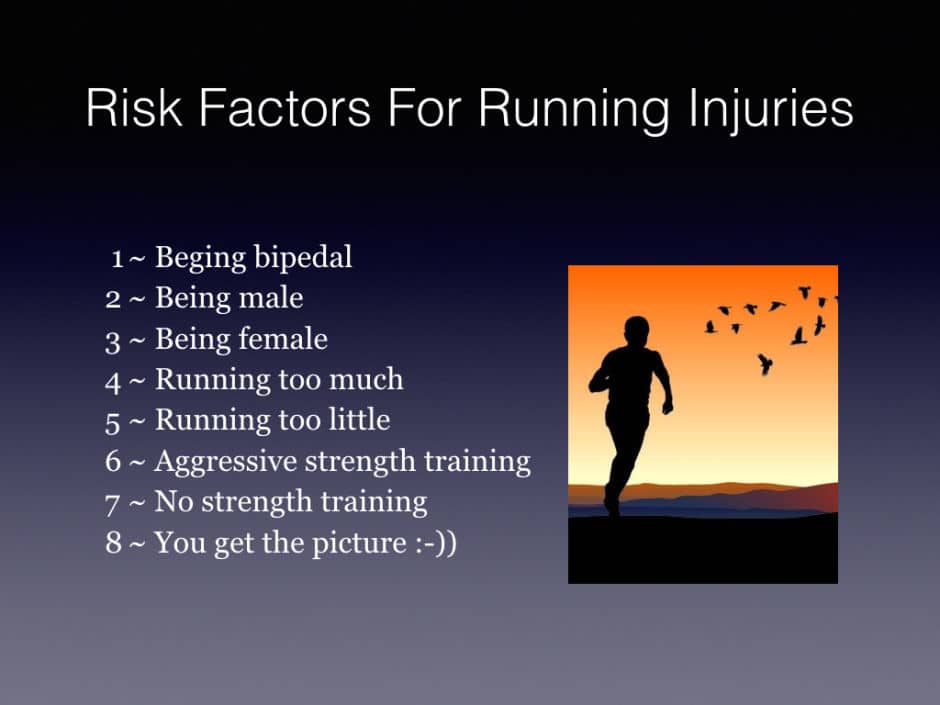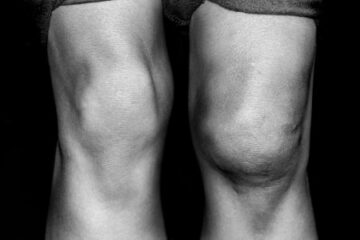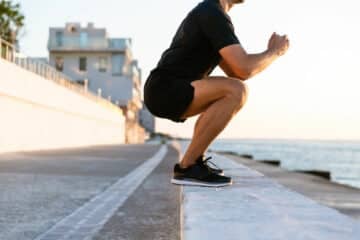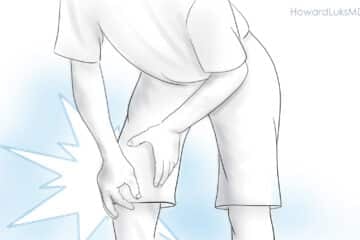
You need a plan to prevent running injuries. Running injuries are going to happen. Every runner is at risk of developing an injury. We have discussed the most common running injuries previously. The most common risk factors associated with running injuries are:
We are all at risk of being injured at some point because of running. Those who are new to running are more likely to suffer. Elite runners are also at risk when they try to notch up their game without a plan and often too rapidly.
An Ounce of Prevention is Worth a Pound of Cure
When we talk about preventing running injuries, we are really talking about delaying most and hopefully shortening your recovery period if you do sustain an injury. There is a misconception among many weekend warriors and runners that running is enough of an exercise alone. This is simply not true. Running is a wonderful exercise to clear the cobwebs or to start the day off with an endorphin rush. Running is a great exercise for cardiac conditioning. But running requires a strong stable core, and strong large and small muscles groups in our legs. Running will not produce those muscular changes, it instead looks to you to provide them. In return, your legs will have a lesser chance of being injured.
Running Injury Prevention Strategies
Know Your Limits:
Great … you started a running or exercise program! A big first step. Your friends run 5 miles a day and you want to join them. You shouldn’t! Not yet. The key to any successful running or exercise program is to build your base. During base building many things are happening to your body.
- Your bones, muscles and tendons are getting used to the new load.
- Your heart and lungs are getting used to the new load
- Your muscles cells are building little factories to harness the food in your blood and turn it into energy.
- Your brain is trying to adapt to the new pattern of exercise.
Your Bones Respond to Running
Your bones will actually become more dense as you exercise. The more dense your bone, the more load you can carry. Your body is very good at conserving resources. So it is not going to spend the energy or waste the calcium on building bones if you are not exercising and your bones do not need to be stronger. It will take many weeks for your bones to start to catch up to you and the load you are putting on them. If you start your training properly, your bones will keep up with you and the risk of stress fractures will diminish dramatically.
Your Tendons and Muscles Respond to Running
Your tendons also respond to stress. Where your muscle or tendon anchors or attaches to bone will become weaker or stronger based on the repetitive load your place on them. The more load you put across your tendons over a period of time, the stronger they become. They develop more attachments to the bone and strengthen the interface between the bone and the tendon. The tendon itself will strengthen dramatically as well. Tendinopathies — which are painful problems with tendons are less common with a well executed training program.
Your Heart Responds To Running:
Your heart has been chilling and pushing just enough blood through your body to meet your needs. When you start running it is in for a rude awakening. For most of us that’s all well and good as long as we exercise well below our maximum heart rate (roughly 221- your age). After a few months of heart rate training your heart will be able to perform the same work with fewer beats.
Your muscles, like every other tissue in your body is used to your prior activity level. Your muscles cells have little factories within them which manufacture the energy you need. When you start to exercise your muscle cells will actually make more of those factories, thus increasing your endurance and strength.
When you begin a running program or any aerobic exercise program you want to pay close attention to your heart rate. Your workouts should feel easy at least 80% of the time your are out there running. Even elite runners work out that way. You want to build your time/mileage slowly… increasing your mileage 10% each week until you hit your goal.
Recovery Is a Necessity For Runners
2. Don’t blow off your recovery time : Recovery is a very important part of any training program. When you run or exercise you are breaking down your tendons and muscles. You are stressing your system. You need to give it time to relax. For beginners you do not string two fast tempo runs back to back. You do not do two long runs, above your usual weekly mileage 2 days in a row. You always take at least one day off per week to let your system recover. Recovery doesn’t always means complete rest and go sit on the couch. If you run 5 miles at 9 minutes per mile pace… then a recovery day can be 3 miles at 11 minutes a mile. In addition… each month you want to incorporate a recovery week. Again, it is not a complete rest. If you are running 30 miles per week at an average pace of 10 minutes/mile then your recovery week is 20 miles at 11 or 12 minutes per mile. These recovery weeks are very important. They allow all the structures we spoke about previously to catch up to you. They are not resting, they’re working very hard to catch up. If you do not give them the chance to catch up, then stress fractures, and tendon injuries happen.
3. Strength Training: Running requires that you participate in a well balanced strengthening and stability program. Most people with running injuries are found to have poor hip muscles and gluteal strength.
A strong butt is the key to being a happy runner.
We do not know if poor core and hip strength lead to injury or if the injury led to diminished strength. We do know that an exercise program to strengthen your hip flexors, extensors, hamstring and abductors, as well as your gluteal muscles will help address many aches and pains that most runners have. Proper strength also improves your posture and gait. Many runners will start to waddle or sway side to side as they tire. That is a set-up for an overuse injury. Proper base building and strengthening will enable you to run further and stronger before your form starts to suffer. Your core will love you if you plank. Planking is one of the best exercises for core strengthening. There are many different varieties of planks to perform and YouTube serves as a great resource.
My favorite exercise for building strength to run:
- Squats
- Lunges
- Posterior Chain Bridge
- Planks
- Calf Raises
I perform these 2-3 days per week.
Your Running Style Matters Too !
Landing on your heel puts on ton of stress on your shins, and your knees. If we take shoes off, or if you run in “minimalist” shoes you will start to run on your toes. By using a midfoot or toe landing pattern, the tendons and ligaments of the foot will disperse a lot of the force of running. Highly cushioned shoes, which typically encourage a heel landing put a lot more stress on the knee then you would imagine. Changing from a heel strike to a mid or toe strike landing pattern may or may not be in your best interest. This is an evolving area of research in the running community.
Your cadence — for most of us– should be above 170. That means that you take at least 170 steps per minute. Sounds really high, right? It’s not, and it’s pretty easy to do. You shorten your stride (distance between your steps) and maintain your pace. That will increase your cadence. A shorter cadence is often a more efficient way to run. People who over-stride… or leap from step to step waste a lot of energy propelling themselves up and forward. High cadence toe runners spend most of their energy propelling themselves forward.
Over-striding and landing on your heel is a key finding in many people with shin splints. Your goal is to have your foot land underneath your body…. not in front of you. If your foot lands in front of you that will place an incredible amount of stress on your tibia and the muscles which will need to carry your ankle through to the toes for take off. Professionals who seek treatment of their shin splints first undergo video analysis of their running pattern. If they are heel strikers and if they over-stride that is the first place that their team will start to work with them to get them back out on the road.
Running Shoes and Running Injury
Keeping your running shoes in good condition and changing them out after 300-350 miles is a good idea. Another good idea is to have more than one pair of running shoes. Each shoe will stress your legs a little differently.
There is a TON written about what constitutes the best running shoe for you. We wrote a post which summarizes a lot of the recent data on shoes here. The bottom line… run in the shoe that feels right ! Most feel are slightly flat or slightly over-pronated, etc… Most of you do not have abnormal anatomy. If you find a shoe that fits great then stay with it. If you run in the heat or if you run long distances you might want to increase your normal size by a ½ size because your foot will become larger as you run.
Of course, I am a doctor… so I MUST tell you to make sure that your doctor says it is safe for you to run and exercise.
Exercising and in particular aerobic exercise and running is a great lifestyle change. You will keep many chronic diseases at bay, you will feel great and you will join the ranks of millions of us who rely on running as a way to clear our minds either before or after a challenging day.















Appropriate analysis It will help me a lot in helping my friends in running